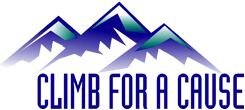Do Well By Doing Good
Training Regimen
Recommended regimen to prepare for a typical Climb For A Cause Annual Event
Important Note
Each participant must accept responsibility for his/her own pre-climb exercise regimen to both ensure your own personal enjoyment as well as the Team’s success as a whole. From another standpoint, lack of conditioning, leading to fatigue, potentially exposes the group to accidents.
For any of you who might be having sentiments along the lines of “How in the heck am I going to get through this thing alive?” let me assure you: each of you has it within yourself to successfully accomplish this goal!
My goal is to ensure a sufficient level of fitness and stamina for you to not only complete the event, but also enjoy yourself in the process. Owing to varying levels of fitness, experience, and a willingness to endure discomfort, it is impossible to objectively rate and share with you the “difficulty” of a hike. I strive to meet with each participant individually, and am happy, at that time, to offer you a reasonable measure of relative difficulty and challenge.
I am presenting you with a twelve-week regimen which, if followed, will help prepare you for an enjoyable experience. Of course, the earlier you get started, the greater you may be assured of success!
First Things First
It’s nearly impossible to get through life without incurring some kind of chronic physical ailment or weakness. Knee, ankle, and hip pain are common. Pain, of course, is the body’s way of telling us something is in need of attention. I continue to be amazed at the human body’s resilience and ability to recover. Nonetheless, if this event qualifies as something out of the ordinary for you, I strongly encourage you to consult your physician, as only he/she is qualified to advise of any special preparations or precautions you might want to take.
Good news. Because this year’s Event will be only one (long) day, all you will be required to carry is a light (10-15 lb.) daypack. This means less wear and tear on the back, shoulders, and joints.
Take It To Heart
A great way to efficiently (and safely) get the most out of your training is to learn to use a heart rate monitor in your training. The rule of thumb is that subtracting your age from 220 determines your Maximum Heart Rate. Trainig at 60-80% of for the majority of your training session will help you attain the optimum aerobic effect.
Once you’ve given yourself a chance to achieve a base level of conditioning (weeks two or three), you should strive to get in at least one long (2-4 hour) training day per week. Be ever mindful, however, that over-training is probably more risky to a successful outcome than is under training. The last thing you want to contend with is some over-use injury. The best thing you can do as Event Day approaches is to taper your training. Come event-day, you can probably count on better performance than you’ve experienced during your training anyway (the so-called Adrenalin Rush).
Following is a recommended training regimen. If you do not have access to a suggested piece of equipment, substitute it with something that works the same muscle group. And if you miss a day, do not “double-up.” Again, be ever mindful of over training, and do not “cram” by training harder as the Event approaches AS THIS IS DEFINITELY COUNTER-PRODUCTIVE!
Suggested Training Regimen (pdf)
Here’s CFAC Alumnus Grant Ritchey telling a bit about how he prepares to Climb For A Cause!
Training videos (and encouragement) follow:
